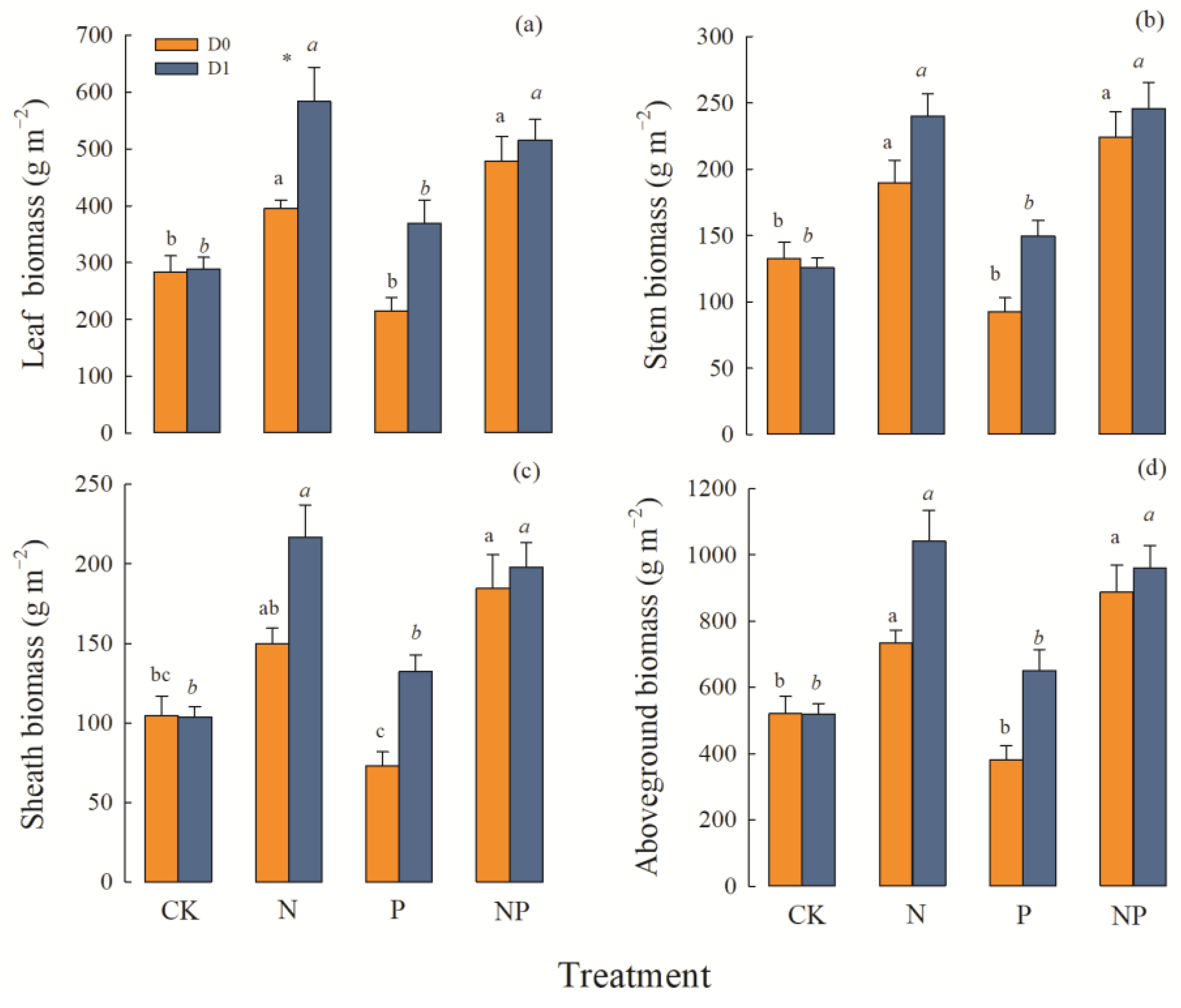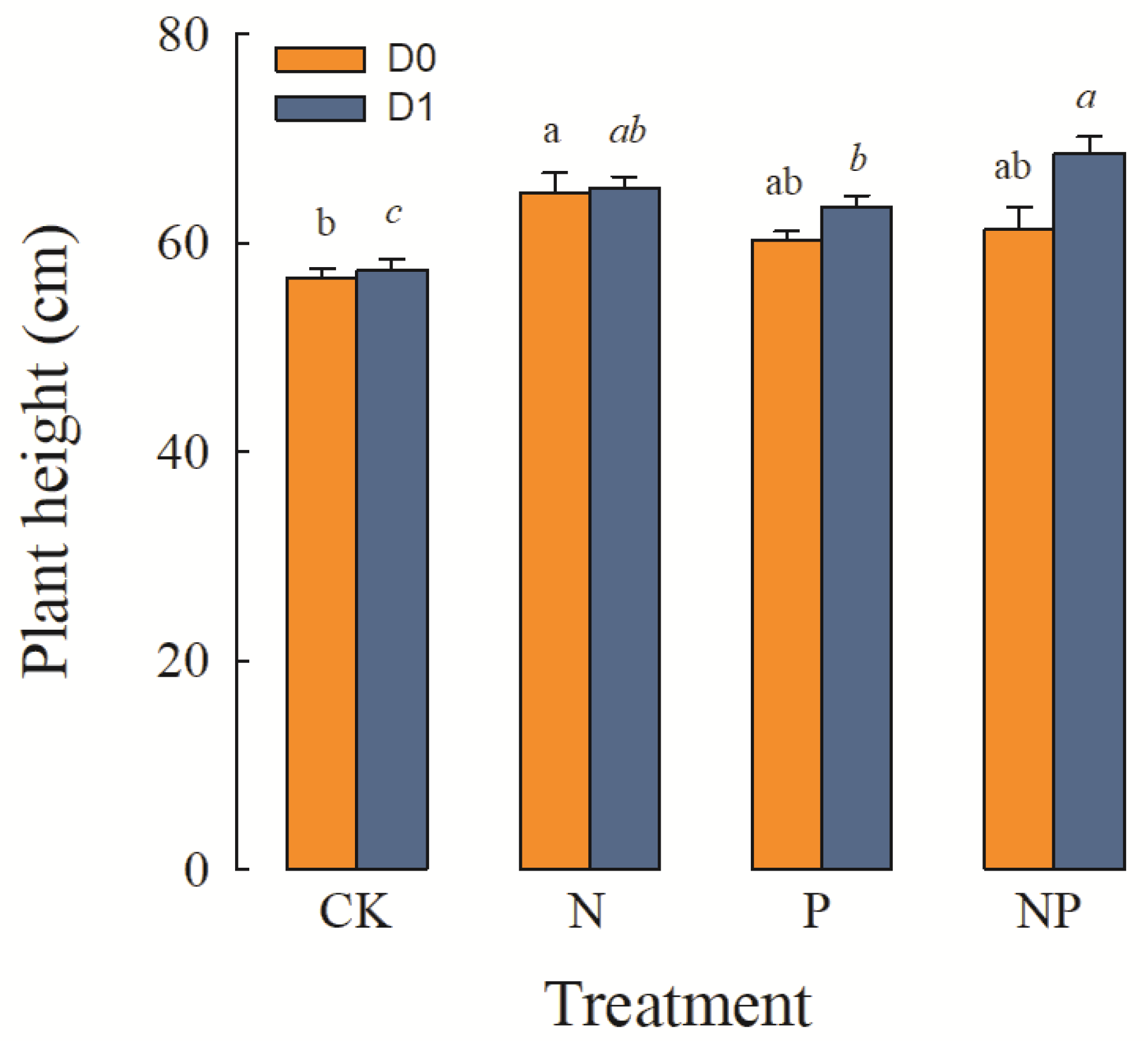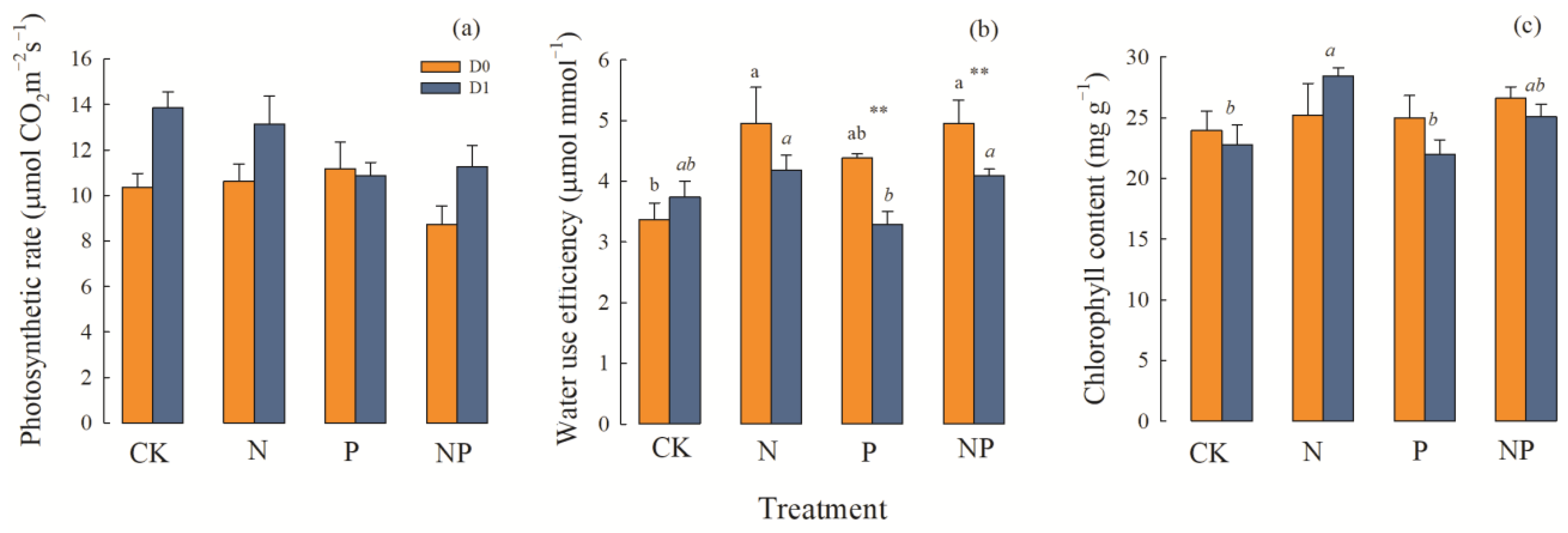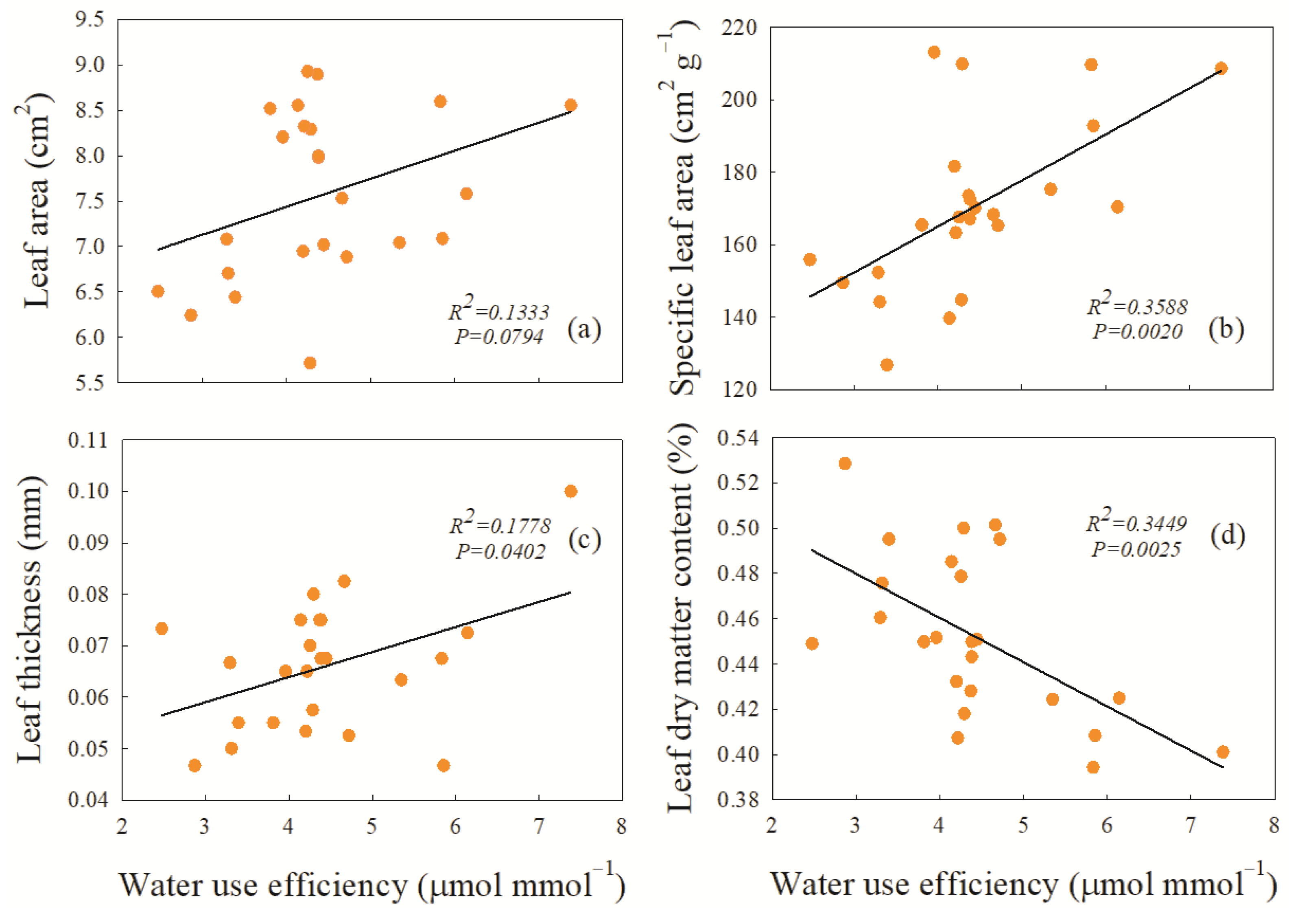The Shift in Key Functional Traits Caused by Precipitation under Nitrogen and Phosphorus Deposition Drives Biomass Change in Leymus chinensis
Abstract
1. Introduction
2. Results
2.1. Biomass and Its Components
2.2. Functional Traits of Individuals
2.2.1. Plant Height and Leaf Morphology Traits
2.2.2. Leaf Photosynthesis-Related Traits
2.3. Effects of Functional Traits on Aboveground Biomass
2.4. The Trade-Off Relationship between Plant Height, WUE, and Leaf Functional Traits
3. Discussion
3.1. Response of Aboveground Biomass to Precipitation Changes and N and P Depositions
3.2. Responses of Leaf Functional Traits to Precipitation Changes and N and P Depositions
4. Materials and Methods
4.1. Experimental Materials
4.2. Experimental Design
4.3. Sampling and Determination Methods
4.4. Data Analysis
5. Conclusions
Author Contributions
Funding
Institutional Review Board Statement
Informed Consent Statement
Data Availability Statement
Acknowledgments
Conflicts of Interest
References
- Yuan, Z.Y.; Li, L.H.; Han, X.G.; Chen, S.P.; Wang, Z.W.; Chen, Q.S.; Bai, W.M. Nitrogen response efficiency increased monotonically with decreasing soil resource availability: A case study from a semiarid grassland in northern China. Oecologia 2006, 148, 564–572. [Google Scholar] [CrossRef]
- Axmanova, I.; Zeleny, D.; Li, C.F.; Chytry, M. Environmental factors influencing herb layer productivity in Central European oak forests: Insights from soil and biomass analyses and a phytometer experiment. Plant Soil 2011, 342, 183–194. [Google Scholar] [CrossRef]
- Giese, M.; Gao, Y.Z.; Lin, S.; Brueck, H. Nitrogen availability in a grazed semi-arid grassland is dominated by seasonal rainfall. Plant Soil 2011, 340, 157–167. [Google Scholar] [CrossRef]
- Shi, Y.J.; Ao, Y.N.; Sun, B.X.; Knops, J.M.H.; Zhang, J.W.; Guo, Z.H.; Wang, J.F. Productivity of Leymus chinensis grassland is co-limited by water and nitrogen and resilient to climate change. Plant Soil 2022, 474, 411–422. [Google Scholar] [CrossRef]
- Wang, J.F.; Knops, J.M.H.; Brassil, C.E.; Mu, C.S. Increased productivity in wet years drives a decline in ecosystem stability with nitrogen additions in arid grasslands. Ecology 2017, 98, 1779–1786. [Google Scholar] [CrossRef]
- Nardini, A.; Luglio, J. Leaf hydraulic capacity and drought vulnerability: Possible trade-offs and correlations with climate across three major biomes. Funct. Ecol. 2014, 28, 810–818. [Google Scholar] [CrossRef]
- Amaral, E.J.; Franco, A.C.; Rivera, V.L.; Munhoz, C.B.R. Environment, phylogeny, and photosynthetic pathway as determinants of leaf traits in savanna and forest graminoid species in central Brazil. Oecologia 2021, 197, 1–11. [Google Scholar] [CrossRef] [PubMed]
- Bobbink, R.; Hornung, M.; Roelofs, J.G.M. The effects of air-borne nitrogen pollutants on species diversity in natural and semi-natural European vegetation. J. Ecol. 1998, 86, 717–738. [Google Scholar] [CrossRef]
- Luo, W.T.; Zuo, X.A.; Ma, W.; Xu, C.; Li, A.; Yu, Q.; Han, X.G. Differential responses of canopy nutrients to experimental drought along a natural aridity gradient. Ecology 2018, 99, 2230–2239. [Google Scholar] [CrossRef]
- Xu, Z.; Zhou, G. Responses of photosynthetic capacity to soil moisture gradient in perennial rhizome grass and perennial bunchgrass. BMC Plant Biol. 2011, 11, 21. [Google Scholar] [CrossRef]
- Agren, G.I.; Wetterstedt, J.A.M.; Billberger, M.F.K. Nutrient limitation on terrestrial plant growth—Modeling the interaction between nitrogen and phosphorus. New Phytol. 2012, 194, 953–960. [Google Scholar] [CrossRef] [PubMed]
- Bobbink, R.; Hicks, K.; Galloway, J.; Spranger, T.; Alkemade, R.; Ashmore, M.; De Vries, W. Global assessment of nitrogen deposition effects on terrestrial plant diversity: A synthesis. Ecol. Appl. 2010, 20, 30–59. [Google Scholar] [CrossRef] [PubMed]
- Valladares, F.; Gianoli, E.; Gomez, J.M. Ecological limits to plant phenotypic plasticity. New Phytol. 2007, 176, 749–763. [Google Scholar] [CrossRef] [PubMed]
- Yan, B.; Ji, Z.; Fan, B.; Wang, X.; He, G.; Shi, L.; Liu, G. Plants adapted to nutrient limitation allocate less biomass into stems in an arid-hot grassland. New Phytol. 2016, 211, 1232–1240. [Google Scholar] [CrossRef] [PubMed]
- Wang, J.F.; Shi, Y.J.; Ao, Y.N.; Wang, J.; Gao, S.; Knops, J.M.H.; Li, Z.J. Long-term summer drought decreases Leymus chinensis productivity through constraining the bud, tiller and shoot production. J. Agron. Crop Sci. 2019, 205, 554–561. [Google Scholar] [CrossRef]
- Vitousek, P.M.; Porder, S.; Houlton, B.Z.; Chadwick, O.A. Terrestrial phosphorus limitation: Mechanisms, implications, and nitrogen-phosphorus interactions. Ecol. Appl. 2010, 20, 5–15. [Google Scholar] [CrossRef]
- Jiang, J.; Wang, Y.P.; Yang, Y.; Yu, M.; Wang, C.; Yan, J. Interactive effects of nitrogen and phosphorus additions on plant growth vary with ecosystem type. Plant Soil 2019, 440, 523–537. [Google Scholar] [CrossRef]
- Rao, L.E.; Allen, E.B. Combined effects of precipitation and nitrogen deposition on native and invasive winter annual production in California deserts. Oecologia 2010, 162, 1035–1046. [Google Scholar] [CrossRef]
- Barker, D.H.; Vanier, C.; Naumburg, E.; Charlet, T.N.; Nielsen, K.M.; Newingham, B.A.; Smith, S.D. Enhanced monsoon precipitation and nitrogen deposition affect leaf traits and photosynthesis differently in spring and summer in the desert shrub Larrea tridentata. New Phytol. 2006, 169, 799–808. [Google Scholar] [CrossRef]
- Mooney, K.A.; Halitschke, R.; Kessler, A.; Agrawal, A.A. Evolutionary Trade-Offs in Plants Mediate the Strength of Trophic Cascades. Science 2010, 327, 1642–1644. [Google Scholar] [CrossRef]
- de Kroon, H.; Huber, H.; Stuefer, J.F.; van Groenendael, J.M. A modular concept of phenotypic plasticity in plants. New Phytol. 2005, 166, 73–82. [Google Scholar] [CrossRef] [PubMed]
- Ohashi, Y.; Nakayama, N.; Saneoka, H.; Fujita, K. Effects of drought stress on photosynthetic gas exchange, chlorophyll fluorescence and stem diameter of soybean plants. Biol. Plant. 2006, 50, 138–141. [Google Scholar] [CrossRef]
- Niu, S.L.; Li, L.H.; Jiang, G.M.; Gao, L.M.; Li, Y.G.; Peng, Y.; Liu, M.Z. Gas exchange and chlorophyll fluorescence response to simulated rainfall in Hedysarum fruticosum var. mongolicum. Photosynthetica 2004, 42, 1–6. [Google Scholar] [CrossRef]
- Wright, I.J.; Reich, P.B.; Westoby, M.; Ackerly, D.D.; Baruch, Z.; Bongers, F.; Villar, R. The worldwide leaf economics spectrum. Nature 2004, 428, 821–827. [Google Scholar] [CrossRef]
- Nie, K.K.; Zhang, M.Z.; Bai, Q.J.; Li, Y. Effects of different nitrogen application strategies on the water and nitrogen use efficiency of greenhouse tomatoes (Solanum lycopersicum). Appl. Ecol. Environ. Res. 2021, 19, 3239–3257. [Google Scholar] [CrossRef]
- Clemo, G.R.; Swan, G.A. The nitrogen cycle in nature. Nature 1949, 164, 811–813. [Google Scholar] [CrossRef]
- Shao, X.; Chantal, K.; Hou, M.M.; Chen, L.H.; Wang, Y.F. Effect of nitrogen and water coupling on growth characteristics and yield quality of flue-cured tobacco (Nicotiana tabacum). J. Food Agric. Environ. 2012, 10, 1096–1099. [Google Scholar]
- Wang, J.F.; Mu, C.S.; Zhang, J.T.; Gao, S.; Li, X.Y. Effects of fertilizer on the sexual reproduction of Leymus chinensis. Acta Prataculturae Sin. 2008, 17, 53–58. (In Chinese) [Google Scholar]
- Tosens, T.; Nishida, K.; Gago, J.; Eduardo Coopman, R.; Marino Cabrera, H.; Carriqui, M.; Flexas, J. The photosynthetic capacity in 35 ferns and fern allies: Mesophyll CO2 diffusion as a key trait. New Phytol. 2016, 209, 1576–1590. [Google Scholar] [CrossRef]
- Wright, I.J.; Dong, N.; Maire, V.; Prentice, I.C.; Westoby, M.; Diaz, S.; Wilf, P. Global climatic drivers of leaf size. Science 2017, 357, 917–921. [Google Scholar] [CrossRef]
- Wright, I.J.; Westoby, M.; Reich, P.B. Convergence towards higher leaf mass per area in dry and nutrient-poor habitats has different consequences for leaf life span. J. Ecol. 2002, 90, 534–543. [Google Scholar] [CrossRef]
- Majekova, M.; de Bello, F.; Dolezal, J.; Leps, J. Plant functional traits as determinants of population stability. Ecology 2014, 95, 2369–2374. [Google Scholar] [CrossRef]
- Wu, J.; Zhao, H.; Wang, X. Soil microbes influence nitrogen limitation on plant biomass in alpine steppe in North Tibet. Plant Soil 2022, 474, 395–409. [Google Scholar] [CrossRef]






| Factor | Precipitation | N | P | Precipitation × N | Precipitation × P | N × P | Precipitation × N × P |
|---|---|---|---|---|---|---|---|
| F | F | F | F | F | F | F | |
| Leaf biomass | 14.155 ** | 63.829 ** | 0.75 | 0.412 | 0.002 | 0.002 | 8.581 ** |
| Stem biomass | 8.485 ** | 90.028 ** | 0.333 | 0.263 | 0.683 | 1.785 | 4.875 * |
| Sheath biomass | 12.116 ** | 71.361 ** | 0.108 | 0.298 | 0.025 | 0.234 | 8.243 ** |
| Aboveground biomass | 13.490 ** | 77.924 ** | 0.138 | 0.384 | 0.044 | 0.206 | 8.304 ** |
| Plant height | 9.047 ** | 31.563 ** | 5.772 * | 0.901 | 5.679 * | 6.200 * | 1.210 |
| Leaf area | 3.794 | 0.941 | 0.123 | 0.714 | 2.056 | 0.141 | 1.347 |
| Specific leaf area | 0.003 | 14.076 ** | 1.242 | 0.217 | 0.428 | 0.469 | 0.003 |
| Leaf thickness | 1.972 | 0.041 | 2.622 | 0.419 | 0.022 | 2.201 | 0.032 |
| Leaf dry matter content | 1.290 | 5.380 * | 0.786 | 3.047 | 0.389 | 0.101 | 0.001 |
| Net photosynthetic rate | 11.050 ** | 0.982 | 5.741 * | 0.572 | 2.350 | 0.409 | 2.388 |
| Water use efficiency | 7.279 ** | 15.132 ** | 0.295 | 1.089 | 3.138 | 0.536 | 2.478 |
| Chlorophyll a + b | 0.313 | 7.030 * | 0.156 | 1.822 | 2.280 | 0.248 | 0.424 |
| Responding Variable | Predictive Variable | β | T | R2 | F | |
|---|---|---|---|---|---|---|
| Control | Aboveground biomass | Water use efficiency | 0.445 | 2.334 * | 0.198 | 5.447 * |
| Precipitation | Plant height | 0.550 | 3.086 ** | 0.302 | 9.524 ** |
Disclaimer/Publisher’s Note: The statements, opinions and data contained in all publications are solely those of the individual author(s) and contributor(s) and not of MDPI and/or the editor(s). MDPI and/or the editor(s) disclaim responsibility for any injury to people or property resulting from any ideas, methods, instructions or products referred to in the content. |
© 2023 by the authors. Licensee MDPI, Basel, Switzerland. This article is an open access article distributed under the terms and conditions of the Creative Commons Attribution (CC BY) license (https://creativecommons.org/licenses/by/4.0/).
Share and Cite
Tong, R.; Yang, X.; Wang, Q.; Li, L.; Li, Y.; Shi, Y.; Mu, C.; Wang, J. The Shift in Key Functional Traits Caused by Precipitation under Nitrogen and Phosphorus Deposition Drives Biomass Change in Leymus chinensis. Plants 2023, 12, 1781. https://doi.org/10.3390/plants12091781
Tong R, Yang X, Wang Q, Li L, Li Y, Shi Y, Mu C, Wang J. The Shift in Key Functional Traits Caused by Precipitation under Nitrogen and Phosphorus Deposition Drives Biomass Change in Leymus chinensis. Plants. 2023; 12(9):1781. https://doi.org/10.3390/plants12091781
Chicago/Turabian StyleTong, Ruqiang, Xinran Yang, Qiuyue Wang, Lin Li, Yanan Li, Yujie Shi, Chunsheng Mu, and Junfeng Wang. 2023. "The Shift in Key Functional Traits Caused by Precipitation under Nitrogen and Phosphorus Deposition Drives Biomass Change in Leymus chinensis" Plants 12, no. 9: 1781. https://doi.org/10.3390/plants12091781
APA StyleTong, R., Yang, X., Wang, Q., Li, L., Li, Y., Shi, Y., Mu, C., & Wang, J. (2023). The Shift in Key Functional Traits Caused by Precipitation under Nitrogen and Phosphorus Deposition Drives Biomass Change in Leymus chinensis. Plants, 12(9), 1781. https://doi.org/10.3390/plants12091781






